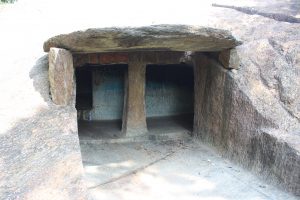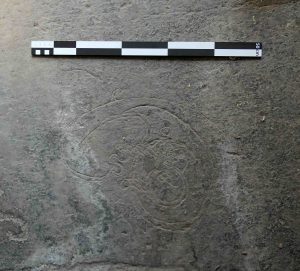IN03198 Habässa Rock Inscription
This inscription is engraved on the wall of a cave at Habässa, the site of an ancient monastery in the forest on the right bank of the Kum̆bukkan Oya, about six miles south-east of the village called Okkampiṭiya in the Buttala Kōraḷē of the Ūva Province. At this site are two long and narrow hummocks of gneiss rock running north-west to south-east. Both have steep overhanging sides, forming a number of caves with drip-ledges. The cave containing the present inscription is one of three caves situated at the southern extremity of the southern range of rock.
The inscription can be dated on the basis of the script and language to the second century A.D. It records the grant of an irrigation channel and three fields to the ancient monastery of Ulibikala-Naka-maha-vihara by the uparāja Naka (Nāga), grandson of King Vahaba (Vasabha) and son of King Utara (Uttara). No king named Uttara is mentioned in the chronicles of Sri Lanka, hence this inscription is of great historical importance as a record of his existence. As his son, Nāga, is described here as a grandson of King Vasabha (r. 66–110 A.D.), it is clear that Uttara was either a son or a son-in-law of the latter – probably a son, since royal genealogies from this period tend to trace the descent directly on the paternal side. The Mahāvaṁsa and the other chronicles mention only one son of Vasabha, namely Vaṁkanāsika Tissa (Tissa the Crooked-Nosed), who succeeded him as king. ‘Uttara’ may, therefore, have been another name of Tissa but it is equally possible that certain historical facts were omitted from the chronicles and that Vasabha did, in fact, have another son who became king.
The present inscription was probably engraved during the reign of Tissa’s son and successor, Gajabāhu I. However, it is noteworthy that the donor of this inscription – an individual called Nāga, who is described here as holding the subordinate rank and office of uparāja – did not deem it necessary to mention the paramount sovereign of the day. In later medieval periods, the title uparāja was generally used by the heir-apparent and the same may be the case here. This conjecture finds support in the chronicles, which record that Gajabāhu’s successor was Mahallaka Nāga (‘Old’ Nāga), indicating that Tissa did have an heir called Nāga.
OB03113 Kaludiyapokuṇa Cave
Kaludiya Pokuna Archaeological Site, Central Province, Sri Lanka
Detail of Kaludiya Pokuna Cave Inscription
IN03138 Kaludiyapokuṇa Cave Inscription
The inscription is engraved on the rock wall of a cave situated about 400 feet to the south-west of the stupa in the ruined monastery at Kalupokuṇa or Kaludiyapokuṇa, which lies on the slopes of a range of hills known as Eravalagala, about a mile and a half to the south-east of Kum̆bukkan̆danvaḷa, in the Vagapaṇaha Pallēsiya Pattu of the Mātaḷē District. The text contains sixty-seven lines, divided into five columns of unequal dimensions. It is dated on the fifth day of the bright half of the lunar month Poson in the eighth year of King Sirisaṅgbo. This biruda was used by a number of kings and it is not possible to identify definitively which one is intended here. However, on palaeographic grounds, Senarath Paranavitana suggests that the monarch in question may be Sena II (r. 866–901) or Kassapa IV (r. 912–929), more probably the former.
The inscription records the gifts made by different individuals for providing food to the inmates of the Dakiṇigiri monastery. The major part of the record is concerned with the gift of a person named Daḷanā, who invested twenty-three kaḷan̆das of gold for the daily supply of two aḍmanā of rice and one aḍmanā of curd and who stipulated that, in the event of dissension among the inmates of the of the monastery, the food intended for them should be thrown to crows and dogs. Evidently, Daḷanā was of opinion that if the members of the saṅgha quarrelled amongst themselves, they were less worthy of the offerings of the pious than such animals.
OB03103 Gäraṇ̆ḍigala Cave No. 3
IN03127 Gäraṇ̆ḍigala Rock Inscription of Kassapa III
The inscription is engraved on two faces of a rock near the entrance to a cave (Cave No. 3) in the rocky hills situated about a quarter of a mile to the north of the village of Damunumulla in Central Province. These hills are known locally as Gäraṇ̆ḍigala (Garandigala, 7.787220, 80.570908) after the snake-like drip-line cut in the rock over one of the caves, gäraṇ̆ḍiyā being the Sinhalese name for the oriental ratsnake (pytas mucosa). The caves were formally used as the abodes of Buddhist mendicants and contain stone beds. The remains of a stūpa and other monastic structures lie to the north of the cave where the present inscription is located.
The inscription registers the names and extent of certain fields granted to the cave by three donors: Mahinda, the heir-apparent; Buddha Mahāmalla; and another individual whose proper name is not preserved. The inscription is dated to the third year of the reign of king Siri Saṁbo. The biruda Siri Saṁbo was used by a number of Sri Lanka kings. However, elsewhere in the inscription, the king is described as Dambdiv dunu, which Senarath Paranavitana translated as ‘who was born in India’. This description could apply to Aggabodhi V, Kassapa III or Mahinda I but only the second of these is believed to have used the biruda Siri Saṁbo. Hence Paranavitana attributes the inscription to Kassapa III (732–738 A.D.). The inscription’s reference to Mahinda, the heir-apparent, supports this attribution, since Kassapa III’s heir was his younger brother Mahinda (later Mahinda I).
The inscription was known to Edward Müller in 1883 (see his Ancient Inscriptions in Ceylon, p. 52, no. 104). It was then was seen by H. C. P. Bell and included as No. 209 in the list of inscriptions forming Appendix F of the Annual Report of the Archaeological Survey of Ceylon for 1911–12.
OB03075 Dim̆bulā-gala Cave 2
Dimbulagala Hills, Sri Lanka
IN03095 Dim̆bulā-gala Mārā-vīdye Rock Inscription
The inscription is engraved on a smooth raised panel on the roof of a cave in the scarp near the summit of the north-westerly side of Dim̆bulā-gala (referred to in the text as Dum̆bulā-gala), a range of hills about ten miles to the south-east of Poḷonnaruva or sixty miles from Anurādhapura in the same direction. The Archaeological Commissioner, H. C. P. Bell, recorded the inscription during his exploration of the locality in September 1897. The text seems to be complete but its unusual ending raises the possibility that it is in fact continued on other nearby panels. Consisting of seven lines, the inscription records that Sundara-mahādevī, the chief queen of Vikrama-Bāhu I and the mother of Gaja-Bāhu II, caused the construction of a road at Dum̆bulā-gala between Sanda-maha-leṇa (the great Moon-cave) and Hiru-maha-leṇa (the great Sun-cave); that she had it paved with stone and had also cave temples built with statues, dāgabas, and sacred bodhi trees; and that she further testifies to a certain benefaction which she had made to Demaḷǟ-pähä.
The text gives the date of this benefaction as the twenty-seventh year after the coronation of Jaya-Bāhu I. However, as Wickremasinghe points out, Jaya-Bāhu I’s reign is believed to have lasted considerably less than twenty-seven years: he ascended to the throne in 1110 and was deposed the following year by his nephew Vikkrama-Bāhu I. The latter reigned for a number of years before being succeeded in 1132 by his son Gaja-Bāhu II, who in turn ruled until 1153. By this chronology, the twenty-seventh year after Jaya-Bāhu’s coronation would have been around 1137, when his great-nephew Gaja-Bāhu II was on the throne. Wickremasinghe therefore dates the present inscription to Gaja-Bāhu II’s reign. Assuming this interpretation is correct, it is highly curious that the inscription’s date should be given from the coronation of a deposed (and by this point deceased) king.
Bhiwkund Maharashtra Lower Cave Pillar Broken Shell Inscription (INNAG0039)

Cave near Bhiwkund Village, Maharashtra, India (21.052010, 79.45922)
Bhiwkund Maharashtra Lower Cave Shell Inscription (INNAG0038)

Cave near Bhiwkund Village, Maharashtra, India (21.052010, 79.45922)

Bhiwkund, Maharashtra. Shell inscription incised on the cave floor.


